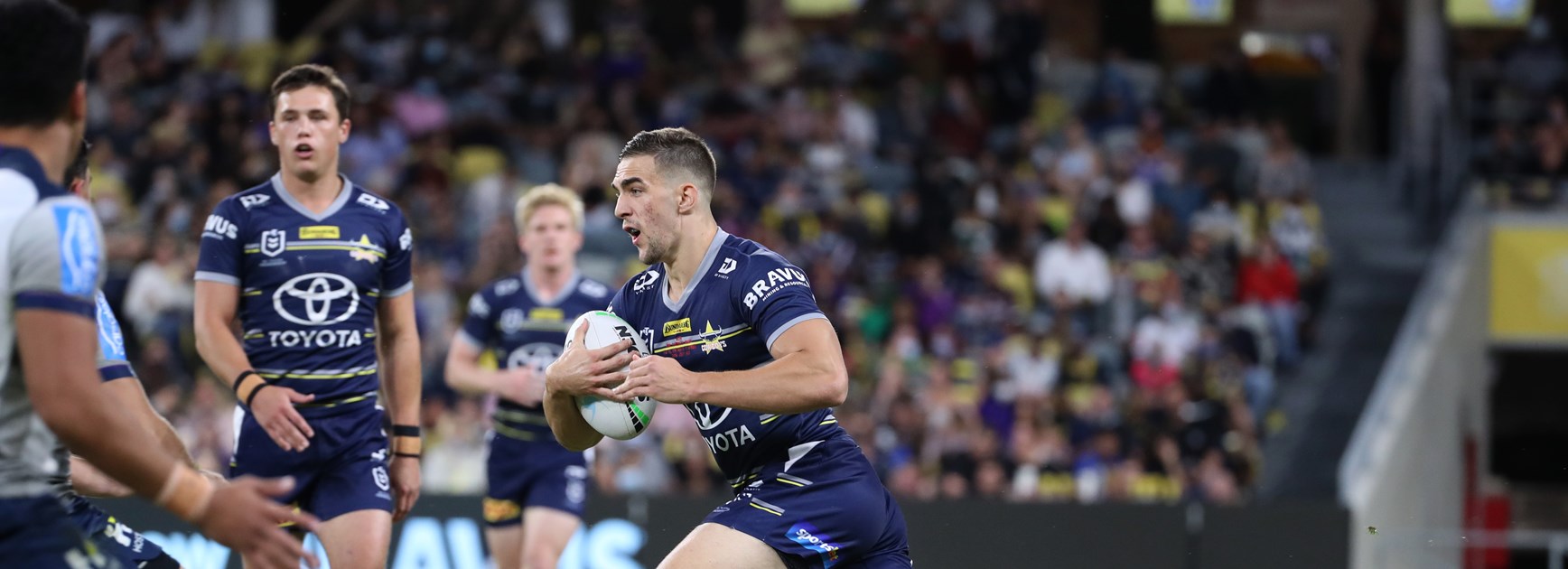
NRL head of football Graham Annesley agrees obstruction calls can be "confusing" for fans but insists all coaches are on board with the rules which help to minimise the involvement of lead runners.
Annesley raised the topic during his Monday media briefing after two tries were disallowed in Friday night's Cowboys-Storm clash.
He said the NRL Bunker was correct to over-rule a try to North Queensland's Kane Bradley because Scott Drinkwater had received the ball on the inside shoulder of lead runner Shane Wright.
However, Annesley believes it was the wrong decision to deny Melbourne's Justin Olam a four-pointer after hooker Brandon Smith ran behind prop Christian Welch before passing to his centre.
While in both cases the lead runner ran through the defensive line and didn't contact any defenders, Annesley explained why the Cowboys' play was rightly pulled up for obstruction.
One hell of a rollercoaster debut for Kane Bradley
"One of the primary indicators of obstruction - which we've agreed with the club coaches, the head coaches ... for quite a number of years now - is this issue about the receiver receiving the ball on the inside shoulder of the lead runner," Annesley said.
"If that happens, it's pretty much a closed case in terms of it being an obstruction ... I know a lot of people don't understand this or don't agree with it, but the coaches certainly do agree with it.
"Although there's no physical obstruction, the coaches view this as a defensive decision that the defensive line needs to make to adjust in order to get to the ball carrier.
Graham Annesley weekly football briefing - Round 19
"Now, you might say, 'Well, [the defender] wasn't going to get there. He wasn't necessarily obstructed in any way or he didn't have to change direction to any great extent'.
"But it has generally been agreed with all the club coaches particularly [about] that issue of receiving the ball clearly on the inside shoulder."
The NRL had previously considered scrapping the inside shoulder indicator but were convinced otherwise.
"We can't have a situation where we just allow lead runners to go through and effectively become blockers without any parameters around it," Annesley said.
"The last time I discussed this with the head coaches as a group, there was a very clear point made to me - because at one point we did decide whether to get rid of the inside shoulder as one of the indicators.
"One of the head coaches made a very clear point - and other coaches agreed in the room - that if we took that away, we will see many more lead runners and there'll be much more obstruction taking place.
"It was going to make it even more complex for the referees and for the Bunker to rule. By keeping that indicator in place, it's not only made it easier for the Bunker and the referees to rule on, but it's also restricted the number of lead runners that we're seeing.
Panthers prepare for Storm without stars
"In years going back, you would see two or three [lead runners] coming through. What using the inside shoulder rule has done is it's generally restricted it now to just one."
As for why Olam should have been awarded his try, Annesley said: "Clearly, the actions of Smith from dummy-half where he ran across the field, ran well behind Welch who was the lead runner - there was no contact from Welch - and clearly passed the ball well by the time he had passed [behind] Welch means there was no obstruction."
Referees boss Jared Maxwell is in constant dialogue with coaches - "on a weekly basis in many cases" - regarding rulings.
"And I know that he's already received feedback from some coaches who watch these incidents, who were absolutely in agreement with the [Cowboys] one, that it was an obstruction," Annesley said.
Cleary perplexed on Yeo ruling
Elsewhere, Annesley addressed "another controversial area" - the on-field punishment of high tackles.
Panthers coach Ivan Cleary questioned why Broncos prop Thomas Flegler was sin-binned instead of sent off for knocking out Isaah Yeo on Saturday night, quipping: "If it was Magic Round, he would have been sent off."
Annesley confirmed there have been "small adjustments" since a high-contact crackdown was implemented in round 10 to "determine what falls into the category of a send-off and a sin-bin and a player placed on report or a penalty on the field".
However, he said the game is still committed to stamping out illegal contact of that nature.
"There has been absolutely no lessening of the intent to eliminate careless and reckless high tackles from the game," he said.
"If we had dropped off you wouldn't even be seeing players go to the sin bin. At times ... people are saying some of those sin-bins in their views are not warranted. But they are still happening.
"What we have tried to do is put a much more specific focus on what constitutes a send-off and a sin bin and player placed on report and just a penalty. There has been an adjustment and I think that is a good thing.
"We would be crazy if we weren't adjusting to try and get it exactly right or as right as it can be. So I'm not walking away from that or trying to hide it."

